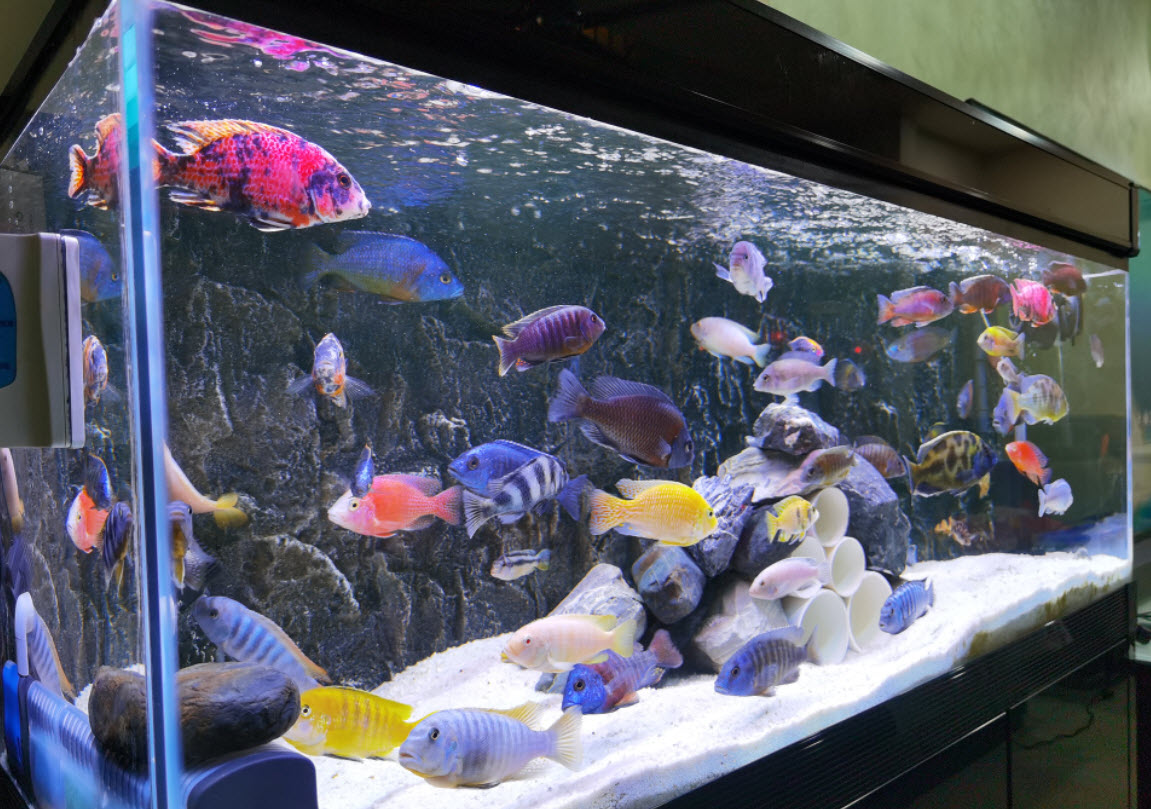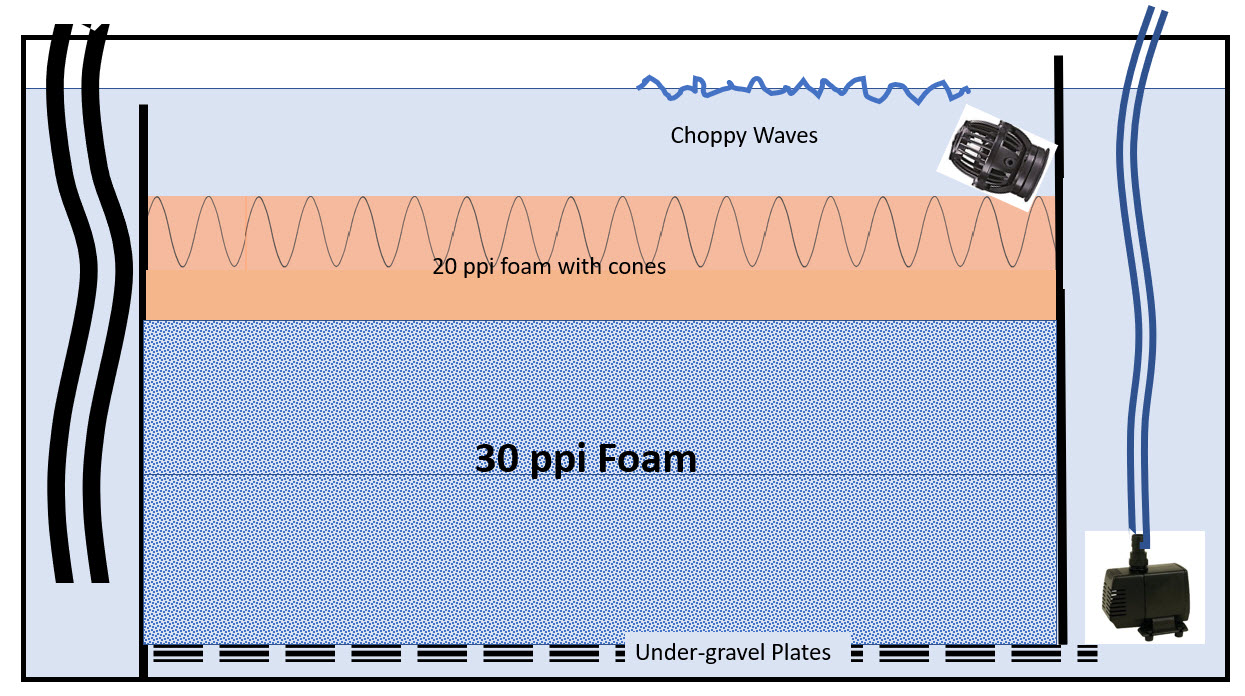
8.6.7. Foam Sump
There is one type of foam sump that is VERY attractive to those who are cowed by the complexity or the noise of a fluidized bed sump. It is a foam/ 2 wavemaker sump. This is what it looks like:

This will have about 60% of the biofiltration capacity of the same volume K1 fluidized bed sump. It will be much easier to set up than the K1. It is much quieter than any of the fluidized K1 designs. If the sump is made very large compared to the bioload and a high protein food is fed, this sump design will never need maintenance.
The surface area of the coned red top piece of foam is very large and the two wavemakers insure a large flow of well oxygenated water over this large surface. These two factors insure the top red piece of foam will never foul.

The Design
Let us go through a build for a 110-gallon heavily stocked mbuna aquarium. What is needed?
Bill of materials:
- 40-gallon breeder aquarium 17 inches high, 36 inches long, 18.25 inches wide.
- 3 inch thick 20 ppi foam red waffle 26×19.5 inch Poret foam sheet or “Macro” foam sheets from China
- Two 4 inch thick 30 ppi blue 26×19.5 Poret foam sheets or “Micro” foam sheets from China
- Thirty-gallon under-gravel filter
- Two side by side bladed circulation pumps
- Two acrylic sheets 18.25 by 13 inches in size, siliconed into the tank, 25.5 inches apart. No holes are needed in the acrylic
- High Pressure Pump capable of lifting 500 gallons per hour against 5 feet of head.
This will give about 10x18x26=4,680 cubic inches 4,680 = 2.7 cubic feet of foam. At roughly 340 square feet per cubic foot of foam, this gives 918 square feet of media surface area. At 100 square feet per pound of fish, this is 9.2 pounds of fish. This is very roughly 7 adult Oscars, or 51 or so adult mbuna, which is HUGE. What might be more amazing is that a K1 fluidized bed in the same volume gives 12 adult Oscars and 78 adult mbuna.
The two bladed circulation pumps at the surface in the 4 inches or so of free water space will aerate the water well, which is important. The bladed pumps will also keep the feces and large particulate matter agitated and broken up rapidly.

Do not use the undergravel lifts. Use ONLY the plates. And do not silicone the plates into place.
For more information on sumps click on the following links:
8.6.1. Sumps in Depth
8.6.2. Static Submerged Media Sumps
8.6.3. Trickle Filters
8.6.4. Wet-dry Sumps
8.6.5 Fluidized Bed Sumps
Note that many beginners are concerned about how to flow the water to a sump. The common refrain is “my aquarium isn’t drilled, how does the water get to the sump?” Click on this link to get some ideas:
14.7. Overflow Devices
.
Return to Filter Menu
Return to Sump Menu
.
Aquarium Science Website
The chapters shown below or on the right side in maroon lead to close to 400 articles on all aspects of keeping a freshwater aquarium. These articles have NO links to profit making sites and are thus unbiased in their recommendations, unlike all the for-profit sites you will find with Google. Bookmark and browse!
.

Dave says
In reply to Cody …… I prefer flow down through the foam. That way your pumping chamber can include the entire foam section.
Dave says
Either are equally good.
Cody Gray says
Another question about foam sumps. As long as there is a layer of water overtop of the foam does it matter if the water goes from top down through the foam or can it go from bottom up through the foam?
Cody Gray says
Hi Dave. I just want to confirm what ppi foam to use. In the diagram here it shows 30ppi foam topped by 20ppi egg crate foam, but under the submerged static media sumps article it shows a diagram of a foam only sump and says 20 ppi foam. Which should be used or are either equally good? Thanks
Dave says
In reply to Clint …… You will need a protein skimmer for saltwater.
Clint says
I’ve had this design running for 6 months now and it is fantastic! Thanks! I have a red cherry shrimp colony that is growing in the sump and they love it (and take care of all of my maintenance)
I’d like to replicate this design for a saltwater tank. Will this design work as is or do I need to add a skimmer?
Dave says
In reply to Clint …. Any water turnover from 1 to 5 is perfectly acceptable
Clint says
Great design. Thanks for sharing. For a freshwater tank do you have a recommendation for water turnover rate for this design? How low would be too low?
Dave says
In reply to Kieran … Yes that is correct.
Kieran says
So with the first acrylic plate we silicone it tight to the bottom of the tank and the second acrylic plate on the outlet side we silicone off the tank floor the thickness of the Undergravel plate?
Dave says
In reply to Noor …. No powerheads or lift tubes on the undergravel, just the plates. And do not silicone the plates to anything.
Noor says
@Dave
Would you also run powerheads on the undergravel folter, or are we just using the plates? Also the acryclic sheets would be siliconed to the undergravel plate correct? Thank you!